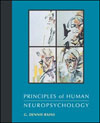G. Dennis Rains,
Kutztown University of Pennsylvania
| afferent | "Toward." Neural input. Thalamic afferents are neurons projecting to the thalamus.
|
 |
 |
 |
| central motor aphasia | A disturbance in verbal expression (but not an aphasia in the traditional sense) seen after prefrontal lesions. It is characterized by reduction in spontaneous speech, diminished verbal fluency, and reduction in the volume and scope of narrative expression. Also called frontal dynamic aphasia and prefrontal aphasia.
|
 |
 |
 |
| convergent thinking | Thinking that hones in on the unique solution to a problem, as opposed to divergent thinking, which expands outward from a starting point, generating novel possibilities and ideas.
|
 |
 |
 |
| corollary discharge | A hypothetical mechanism by which activity of the motor system is integrated with input to the sensory-perceptual system so that bodily movement (e.g., the moving of the eyes) is not mistaken for movement of the world.
|
 |
 |
 |
| divergent thinking | Thinking that expands outward from a starting point, generating novel possibilities and ideas, as opposed to convergent thinking, which hones in on the unique solution to a problem.
|
 |
 |
 |
| dysexecutive syndrome | A syndrome seen after dorsolateral prefrontal lesions that is characterized by impaired attention, diminished drive, reduced awareness, and depressed mood. Impairment in working memory, the temporal integration of behavior, and planning is also seen in this syndrome, as is impairment in the ability to initiate spontaneous and deliberate behavior and to maintain such behavior in a manner necessary for attaining goals. Also called dorsolateral prefrontal syndrome.
|
 |
 |
 |
| efferent | "Away from." Neural output. Thalamic efferents are neurons projecting out of the thalamus.
|
 |
 |
 |
| environmental dependency syndrome | The tendency of individuals with prefrontal lesions to rely on the environment for cues to regulate their behavior.
|
 |
 |
 |
| exclusionary attention | The inhibition of attention and responsiveness to features of the environment that are not relevant to our goals. See also selective attention.
|
 |
 |
 |
| executive function | (1) A group of functions that includes the formulation of goals, the development and execution of strategies to achieve those goals, the monitoring and evaluation of the extent to which these strategies may or may not be contributing to reaching the goals, and the adaptive modification of (or persistence in) behavioral strategies (and possibly also the goals themselves) in light of this evaluation. Lesions to prefrontal cortex disrupt executive function. (2) In the context of working memory, the component that takes care of the overall coordination of activities in working memory, including which content and processes should be shuffled in and out of the workspace.
|
 |
 |
 |
| frontal dynamic aphasia | Luria's term for a disturbance in verbal expression (but not an aphasia in the traditional sense) seen after prefrontal lesions. It is characterized by reduction in spontaneous speech, diminished verbal fluency, and reduction in the volume and scope of narrative expression. Also called central motor aphasia and prefrontal aphasia.
|
 |
 |
 |
| frontal eye field (FEF) | A region of the frontal lobes anterior to the premotor area and dorsal to Broca's area involved in the cortical control of purposeful eye movement.
|
 |
 |
 |
| ideational fluency | The ability to creatively generate novel ideas.
|
 |
 |
 |
| medial prefrontal cortex | Region of the frontal lobes on the interior surface of the cerebral hemispheres.
|
 |
 |
 |
| orbital (ventral) prefrontal cortex | Area of the frontal lobes on the ventral surface of the cerebral hemispheres. It is named for its proximity to the orbits (the bony cavities that contain the eyeballs). Also called ventral prefrontal cortex.
|
 |
 |
 |
| prefrontal aphasia | A disturbance in verbal expression (but not an aphasia in the traditional sense) seen after prefrontal lesions. It is characterized by reduction in spontaneous speech, diminished verbal fluency, and reduction in the volume and scope of narrative expression. Also called central motor aphasia and frontal dynamic aphasia.
|
 |
 |
 |
| prospective memory | The capacity to internally represent future events and utilize these representations to guide problem solving and future behavior.
|
 |
 |
 |
| pseudodepression | A constellation of symptoms, seen after prefrontal lesions, that overlaps with many of the symptoms of major depressive disorder, including depressed mood and apathy.
|
 |
 |
 |
| pseudopsychopathy | A syndrome seen after prefrontal lesions that is characterized by an apparent disregard for the effect of one's behavior on others. The syndrome's name comes from it similarity to psychopathy (now termed antisocial personality disorder).
|
 |
 |
 |
| script | Knowledge of the behavior that is adap-tive in a particular situation, such as eating at a restaurant.
|
 |
 |
 |
| selective attention | Focusing of attention on features of the environment that are relevant to goal-directed behavior. See also exclusionary attention.
|
 |
 |
 |
| stimulus bound | Impairment in the normal ability to inhibit overlearned or automatic responses to a stimulus.
|
 |
 |
 |
| temporal integration of behavior | The ability to organize, initiate, and carry out novel patterns of goal-directed behavior over extended time periods.
|
 |
 |
 |
| utilization behavior | The tendency to use objects in the environment without obvious prior intention to do so.
|



 2002 McGraw-Hill Higher Education
2002 McGraw-Hill Higher Education